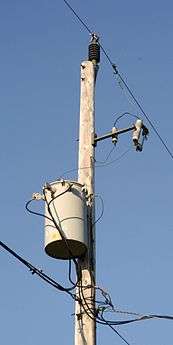Single-phase electric power
In electrical engineering, single-phase electric power is the distribution of alternating current electric power using a system in which all the voltages of the supply vary in unison. Single-phase distribution is used when loads are mostly lighting and heating, with few large electric motors. A single-phase supply connected to an alternating current electric motor does not produce a rotating magnetic field; single-phase motors need additional circuits for starting (capacitor start motor), and such motors are uncommon above 10 kW in rating.

Because the voltage of a single phase system reaches a peak value twice in each cycle, the instantaneous power is not constant.[1]
A single-phase load may be powered from a three-phase distribution transformer in two ways: by connection between one phase and neutral or by connection between two phases. These two give different voltages from a given supply. For example, on a 120/208 three-phase system, which is common in North America, the phase-to-neutral voltage is 120 volts and the phase-to-phase voltage is 208 volts. This allows single-phase lighting to be connected phase-to-neutral and three-phase motors to be connected to all three phases. This eliminates the need of a separate single phase transformer.
Standard frequencies of single-phase power systems are either 50 or 60 Hz. Special single-phase traction power networks may operate at 16.67 Hz or other frequencies to power electric railways.[2]
Splitting out
Single-phase is commonly divided in half at the distribution transformer on the secondary winding to create split-phase electric power for household appliances and lighting.[2]
Applications
In North America, individual residences and small commercial buildings with services up to about 100 kVA (417 amperes at 240 volts) will usually have three-wire single-phase distribution, especially in rural areas where motor loads are small and uncommon. In rural areas where no three-phase supply is available, farmers or households who wish to use three-phase motors may install a phase converter. Larger consumers such as large buildings, shopping centers, factories, office blocks, and multiple-unit apartment blocks will have three-phase service. In densely populated areas of cities, network power distribution is used with many customers and many supply transformers connected to provide hundreds or thousands of kVA, a load concentrated over a few hundred square meters.
High-power systems, say hundreds of kVA or larger, are nearly always three-phase. The largest supply normally available as single-phase varies according to the standards of the electrical utility. In the United Kingdom a single-phase household supply may be rated 100 A or even 125 A, meaning that there is little need for three-phase in a domestic or small commercial environment. Much of the rest of Europe has traditionally had much smaller limits on the size of single phase supplies resulting in even houses being supplied with three-phase (in urban areas with three-phase supply networks).
If heating equipment designed for a 240-volt system is connected to two phases of a 208-volt supply, it will only produce 75% of its rated heating effect. Single-phase motors may have taps to allow their use on either 208-volt or 240-volt supply.
Single-phase power may be used for electric railways; the largest single-phase generator in the world, at Neckarwestheim Nuclear Power Plant, supplied a railway system on a dedicated traction power network.
Grounding
Typically a third conductor, called ground (or "safety ground") (U.S.) or protective earth (UK, Europe, IEC), is used as a protection against electric shock, and ordinarily carries significant current only when there is a circuit fault.[2] Several different earthing systems are in use. In some extreme rural areas single-wire earth return distribution is used.
References
- "What's the Difference Between Single Phase and Three Phase AC Power Supplies?". Aegis Power Systems. Aegis Power Systems. Retrieved 28 December 2015.
- Terrell Croft and Wilford Summers (ed), American Electricians' Handbook, Eleventh Edition, McGraw Hill, New York (1987) ISBN 0-07-013932-6, chapter 3, pages 3-10, 3-14 to 3-22.